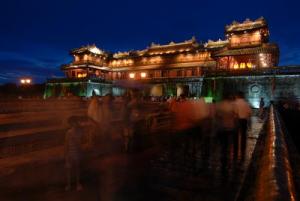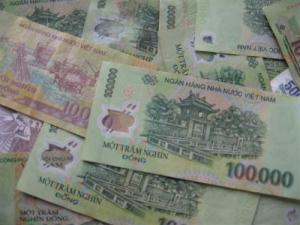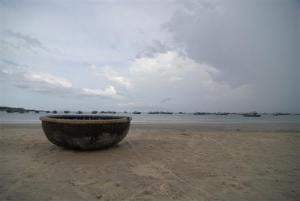Nước mắm – soul of Vietnamese dishes

In Vietnamese cuisine, unique taste and specialties of dishes depend upon the well-blended of various kinds of traditional condiments. A secret ingredient surprises many professional cookers, talented chefs and food lover, an essential to create a unique taste for Vietnamese savory dishes is “Nước mắm” (Vietnamese fish sauce). The saltiness, but not pure salty, blend on the back-base sweetness scores the winning of fish sauce.
Nước mắm is a very basic and common condiment uses across Vietnam. The way Nước mắm is added, balanced in dishes, though, might different from regions but in general, it is a must have condiment in cooking.
Famous brands and history of Nước mắm
“Nước mắm Phú Quốc” and “Nước mắm Phan Thiết” are the most famous commercial brands of fish sauce trading on domestic and international markets. The sea surrounding Phu Quoc islands has a huge economic potential of anchovies. It creates a long history of Nước mắm Phú Quốc dating back to 200 years ago when islanders made and trade Nước mắm to Laos and Cambodia at the end of 19th century. Today, “Dương Ðông” and “An Thới” are two locations contribute a significant output to Nước mắm Phú Quốc production.
“Nước mắm Phan Thiết” originates in Phan Thiet, a local coastal area in Central of Vietnam with an approximate of 57 kilometers long of coastline. Local people are well-known with many traditional villages of making Nuoc mam. Like Phu Quoc, Phan Thiet has plentiful supply of anchovies, a primary ferment ingredient of fish sauce. Nước mắm Phan Thiết has presented on the market since 1809 and it has become a favorite and famous brand. Thanh Hải, Phú Hài and Hàm Tiến – Mũi Né are three famous areas among villages making Nước mắm.
How “Nước mắm” is made
Nước mắm is a liquid condiment derived from fish that are ferment. The most common fish to make Nước mắm, in Vietnam, is anchovies. This explains a large number of traditional and famous villages in making Nước mắm locate in coastal areas or islands to utilize a plenty of fresh fish supply. The distinctive type of anchovies and the quality of fish are the key elements in having the best quality and flavorful fish sauce. July to December lunar calendar, particularly in August, is the best season during the year for fishing anchovies. Anchovies, right at the fishing boat, are washed in sea water and taken out impurities. Fish, then, is mixed with unrefined salt and store in the hold. The ratio of fish and salt, usually, is 3:1- three parts of fish mix with one part of unrefined salt. This method is traditionally called “chượp” to keep fish fresh; avoid the disintegration of fish meat to yield the highest degree of protein for fish sauce and fantastic smell. When the fishing boat returns to the mainland, salted fishes are put into a huge wooden barrel to keep for months.
A wooden barrel is made from soft wood because each wooden piece is arranged to form a huge barrel and big ropes are used to keep them stay closed and tied together without any tiny slot. Soft wood, thus, forms a better barrel than other types of wood. A wooden barrel has cylindrical shape with 1,5 to 3 meters in diameter; 2 to 2,5 meters in height; 2,5 to 8 cubic meters in capacity. Each barrel can store 7 to 13 tons of fish. When a barrel is filled-up with salted fishes, one layer of fish will be put on top with another layer of salt, then, stay on top of that is a bamboo grid and a layer of stone to fasten and weight fishes down. Two to four days later, the enzymes in fish gut hydrolyze internal organs and create some liquid. This very first liquid has fishy smell and uneatable, so it is filtered out via a small tap on the wall of barrel. When all liquid are out, the main hydrolysis process begins. It takes 8 to 18 months for certain bacteria finish hydrolysis of fish meat and discharge transparent, light yellow or reddy brown liquid – known as perfect Nước mắm, no fishy but having a distinct aromatic smell.
This first, perfect liquid has the highest degree of protein called “nước mắm nhĩ” which is purely created from the hydrolysis of fish meat. After filtering out the first product, water can be filled again into the barrel for the second derivation, though, not having a high degree of protein as the first one. The degree of protein is reduced over each production cycle.
Nước mắm, then, is bottled for retailing or packed in plastic container for wholesales distribution. A fundamental difference between “Nước mắm Phú Quốc” and “Nước mắm Phan Thiết” is the color. Nước mắm Phú Quốc has a natural reddy brown color without adding any artificial color. This is a result of fresh fish mixing method and a long period of ferment up to 12 months in wooden barrels. Nước mắm Phan Thiết has a yellow color of straw with a strong scent and bold sweetness, a result of high degree of protein. This is a part of geographic advantages of Phan Thiet, a place with high average temperature, low humidity, full of sunshine and wind which cause an impact on the ferment mechanism of fish.
Nước mắm and Nước mắm chấm
Nước mắm is seasoned itself as raw fish sauce or mixed with other ingredients to have “Nước mắm chấm” (dipping sauce) to go along with various dishes. Raw nước mắm is a well-known condiment in cooking Vietnamese savory dishes in lieu of salt. It creates a unique taste and flavor, a well-blended of saltiness and sweetness of fish meat that could not find in any other salty condiments.
Nước mắm chấm or mixed fish sauce is a common name known as Vietnamese dipping sauce which serves as a condiment for many savory dishes. Nước mắm chấm is made from raw fish sauce, basically, mixed with sugar, lemon juice, chili pepper and water. However, Nước mắm chấm varies from regions and type of dishes. In the North of Vietnam, it’s called Nước mắm pha which is mixed with broth rather than water. In the Central, people prefer a thick Nước mắm chấm which is mixed with the same proportion of raw fish sauce, sugar, lemon juice but less water. Down to the South of Vietnam, people tend to mix fish sauce with coconut juice instead of water and Nước mắm chấm is diluted and sweet.
Each type of savory dishes has different kind of Nước mắm chấm. For wrap and roll dishes such as Chả giò (Vietnamese fried egg roll); Gỏi cuốn (Vietnamese spring roll); Bánh xèo (Vietnamese pan-fried crepe) or rice dishes like Cơm tấm (Vietnamese broken rice) and vermicelli dishes such as Bún thịt nướng, Bún chả giò, Nước mắm chấm is mixed with one part of raw fish sauce, ¾ part of water and ¼ part of sugar, minced garlic and chili pepper. It tends to be sweet and diluted. Sometimes, pickled julienne daikon and carrot are added to enhance the presentation and give some crunch. For special dishes of Hue such as Bánh bèo, bánh bột lọc…, Nước mắm chấm is only mixed with water, sugar and a few drop of lemon juice. It is lightly sweet and not sour. Chili pepper is chopped and put a side instead of mixing in fish sauce.
Apparently, no one denies that what make a dish more impressive and traditional depend upon a part of delicious dipping sauce. It not only enhances bold taste, richness of the dish but it reflects a true culinary culture of a perfect combination among ingredients and exposes the art of cooking.
Nước mắm (Vietnamese fish sauce), true, is a secret weapon of Vietnamese cuisine to create unique flavor and deliver surprise to people. With regards to this simple but special condiment, Nước mắm is well known as soul of Vietnamese cuisine.









